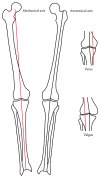High Tibial Osteotomy: Review of Techniques and Biomechanics
- PMID: 31191853
- PMCID: PMC6525872
- DOI: 10.1155/2019/8363128
High Tibial Osteotomy: Review of Techniques and Biomechanics
Abstract
High tibial osteotomy becomes increasingly important in the treatment of cartilage damage or osteoarthritis of the medial compartment with concurrent varus deformity. HTO produces a postoperative valgus limb alignment with shifting the load-bearing axis of the lower limb laterally. However, maximizing procedural success and postoperative knee function still possess many difficulties. The key to improve the postoperative satisfaction and long-term survival is the understanding of the vital biomechanics of HTO in essence. This review article discussed the alignment principles, surgical technique, and fixation plate of HTO as well as the postoperative gait, musculoskeletal dynamics, and contact mechanics of the knee joint. We aimed to highlight the recent findings and progresses on the biomechanics of HTO. The biomechanical studies on HTO are still insufficient in the areas of gait analysis, joint kinematics, and joint contact mechanics. Combining musculoskeletal dynamics modelling and finite element analysis will help comprehensively understand in vivo patient-specific biomechanics after HTO.
Figures



Similar articles
-
Five-year changes in gait biomechanics after concomitant high tibial osteotomy and ACL reconstruction in patients with medial knee osteoarthritis.Am J Sports Med. 2015 Sep;43(9):2277-85. doi: 10.1177/0363546515591995. Epub 2015 Aug 11. Am J Sports Med. 2015. PMID: 26264767 Clinical Trial.
-
The effects of valgus medial opening wedge high tibial osteotomy on articular cartilage pressure of the knee: a biomechanical study.Arthroscopy. 2007 Aug;23(8):852-61. doi: 10.1016/j.arthro.2007.05.018. Arthroscopy. 2007. PMID: 17681207
-
Change of Chondral Lesions and Predictive Factors After Medial Open-Wedge High Tibial Osteotomy With a Locked Plate System.Am J Sports Med. 2017 Jun;45(7):1615-1621. doi: 10.1177/0363546517694864. Epub 2017 Mar 14. Am J Sports Med. 2017. PMID: 28291955
-
[Medial opening wedge high tibial osteotomy].Oper Orthop Traumatol. 2017 Aug;29(4):294-305. doi: 10.1007/s00064-017-0509-5. Epub 2017 Jun 22. Oper Orthop Traumatol. 2017. PMID: 28642979 Review. German.
-
Comparison of navigated and conventional high tibial osteotomy for the treatment of osteoarthritic knees with varus deformity: A meta-analysis.Int J Surg. 2018 Jul;55:211-219. doi: 10.1016/j.ijsu.2018.03.024. Epub 2018 Mar 16. Int J Surg. 2018. PMID: 29555521 Review.
Cited by
-
Comparison of Trends and Complications of Unicompartmental Knee Arthroplasty Versus Periarticular Knee Osteotomy Among ABOS Part II Oral Examination Candidates.Orthop J Sports Med. 2024 Jul 31;12(7):23259671241257818. doi: 10.1177/23259671241257818. eCollection 2024 Jul. Orthop J Sports Med. 2024. PMID: 39100213 Free PMC article.
-
Functional Outcome of High Tibial Osteotomy in Patients with Medial Compartment Osteoarthritis Using Dynamic Axial Fixator -a prospective study.J Clin Orthop Trauma. 2020 Oct;11(Suppl 5):S902-S908. doi: 10.1016/j.jcot.2020.07.033. Epub 2020 Jul 31. J Clin Orthop Trauma. 2020. PMID: 32999578 Free PMC article.
-
Long-Term Survivorship of Closed-Wedge High Tibial Osteotomy for Severe Knee Osteoarthritis: Outcomes After 10 to 37 Years.Orthop J Sports Med. 2021 Oct 20;9(10):23259671211046964. doi: 10.1177/23259671211046964. eCollection 2021 Oct. Orthop J Sports Med. 2021. PMID: 34692884 Free PMC article.
-
Patient Characteristics Related to Blood Loss in High Tibial Osteotomy in Novel Multiple Linear Regression Analysis.Biomed Res Int. 2020 May 1;2020:8965925. doi: 10.1155/2020/8965925. eCollection 2020. Biomed Res Int. 2020. PMID: 32462029 Free PMC article.
-
Knee osteotomy combined with meniscal allograft transplantation versus knee osteotomy alone in patients with unicompartmental knee osteoarthritis: a prospective double-blind randomised controlled trial protocol.BMJ Open. 2024 Dec 12;14(12):e087552. doi: 10.1136/bmjopen-2024-087552. BMJ Open. 2024. PMID: 39672576 Free PMC article.
References
-
- Chen Z., Zhang X., Ardestani M. M., et al. Prediction of in vivo joint mechanics of an artificial knee implant using rigid multi-body dynamics with elastic contacts. Proceedings of the Institution of Mechanical Engineers, Part H: Journal of Engineering in Medicine. 2014;228(6):564–575. doi: 10.1177/0954411914537476. - DOI - PubMed
Publication types
MeSH terms
LinkOut - more resources
Full Text Sources

